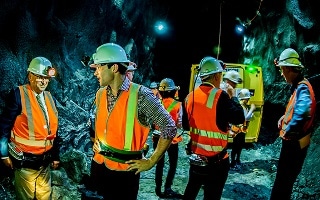May 23 2016
In an Australian gold mine, a kilometre underground, an international team are searching for the Universe’s dark side.
 Researchers Jeremy Mould (left) and Alan Duffy inside the Stawell Underground Physics Laboratory (Swinburne University of Technology)
Researchers Jeremy Mould (left) and Alan Duffy inside the Stawell Underground Physics Laboratory (Swinburne University of Technology)
There are invisible particles that, combined, outweigh all the atoms in all the planets, stars and galaxies that we can see, by five times. These particles are called dark matter, and their lack of interaction with light confers them with phantom-like properties, so that they can fly through atoms of solid matter as if they were empty space. Understanding the nature of these particles would give scientists insights into one of astronomy’s biggest mysteries.
One way researchers could learn more about dark matter is from the headwind of dark matter the Earth ploughs through at approximately 220 kilometres per second. As this dark matter wind ‘blows’ through the Earth, it will occasionally collide with the nucleus of an atom causing the atom to recoil. Spotting these chance collisions is the pursuit of the Southern Hemisphere’s first dark matter detector, SABRE (Sodium-iodide with Active Background REjection), an experiment locally co-led by Swinburne University of Technology’s Professor Jeremy Mould and the University of Melbourne’s Elisabetta Barberio.
“SABRE exploits an unusual property of sodium iodide crystals doped with thallium. Recoiling atoms emit a faint flash of light on colliding with dark matter,” says Swinburne’s Dr Alan Duffy, an astrophysicist involved with the project.
The challenge is that many extraneous flashes will be emitted due to collisions with cosmic rays and muons from space or background radiation. SABRE itself would also emit radiation, but to negate this, the Melbourne researchers have drawn on the expertise of Princeton University’s Frank Calaprice and his team. They have grown one of the purest crystals ever attempted to limit the radiation from SABRE.
To escape the constant bombardment from space the SABRE team, in collaboration with Newmarket Gold and Northern Grampians Shire, created the Stawell Underground Physics Laboratory (SUPL) a kilometre underground in a gold mine in Victoria. Team members from the national nuclear agencies of Australia (ANSTO) and Italy (INFN) and CoEPP, Australia’s ARC particle physics centre of excellence, will ensure that SUPL will be one of the lowest-radiation locations on Earth. With $3.5 million funding from the Victorian government and Australia’s national government, and in-kind support from partner institutes, SABRE will be operative in a year. “Swinburne, along with the rest of Australia, will then be at the forefront of the world’s efforts to uncover the nature of dark matter,” says Duffy.
The wider industrial and scientific communities are also showing interest in the unique SUPL facility. The low background radiation environment is ideal for testing novel neutron detectors, which can be used to help spot smuggled nuclear material. The facility’s detector technology can also perform tomographic scans of the surrounding mine to locate heavy metals. This is because metals such as bodies of gold ore block muon particles, much like bones block X-rays in medical scans.
Source: http://www.swinburne.edu.au/